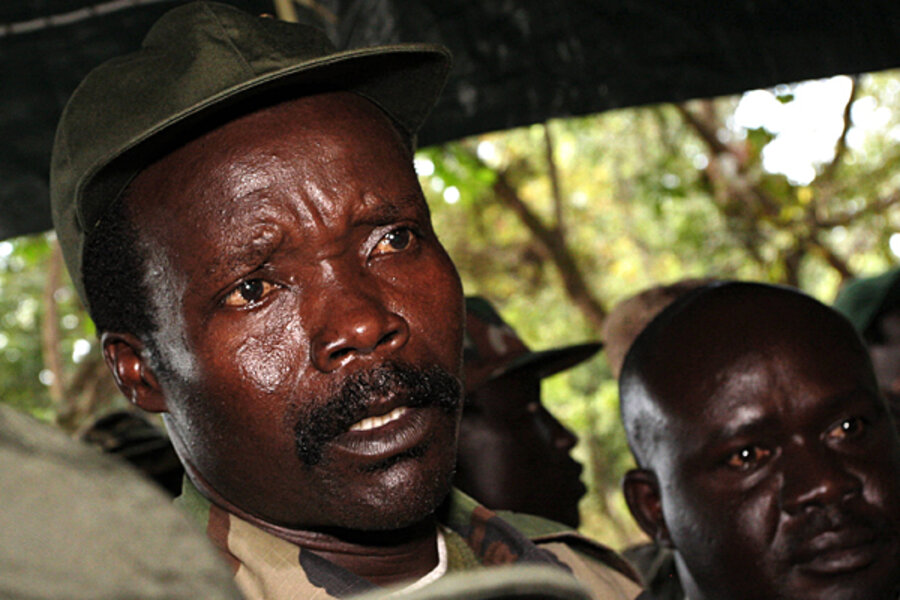Kony 2012: 75 million viewers later, some Ugandans get first glimpse of film
Loading...
| Nairobi, Kenya
Soon after sunset Tuesday, on a projector screen in a dusty park in the center of a northern Ugandan town, survivors of Joseph Kony’s war of terror will watch the film about him that has swept the world and been watched more than 75 million times on YouTube.
Few in Lira, once the epicentre of fighting between Kony’s rebels and the Ugandan armed forces, have access to the Internet at speeds that will allow the 30-minute film to stream.
But Victor Ochen, director of a Ugandan charity working with people abducted or maimed by Kony’s Lord’s Resistance Army (LRA), is making sure that they will be able to see Kony2012.
“We have brought a projector up here and a very big screen, and even as I talk to you, we are setting it up in Lira Mayor’s Garden,” he tells the Monitor from the town, 220 miles north of the capital, Kampala. “It is only right that this thing which is being talked about in every corner of the world is also seen by the people whose story it sets out to tell.”
The film, made by Invisible Children Inc., a San Diego-based activist organization, aims to focus US efforts to help bring about the arrest of Joseph Kony (pronounced Kohn), the LRA’s leader. While it has spawned a global debate on the merits of Invisible Children's movie and social media campaign, little of the reaction – even from within Uganda – has come from those who have lived for years in the shadow of the conflict.
Mr. Kony's 26-year war started in northern Uganda, where tens of thousands of children were abducted to be soldiers, “wives,” or porters, and where thousands more who resisted were permanently disfigured. Kony became the first suspect indicted by the International Criminal Court, in 2005, and faces 33 charges including murder, rape and kidnapping children.
Invisible Children, and Kony2012’s director, Jason Russell, have been criticized for over-simplifying the conflict’s causes and for spending more money on management, media, and movies than on grass-roots projects.
This issue 'still needs more attention'
But Mr. Ochen, whose brother and cousin were both kidnapped by the LRA and are still missing, says the criticism misses a key point.
“How would we ever be able to have so much global attention come to us, on an issue which has been running for almost three decades, and which still needs more attention on a daily basis,” he asks.
“That film has put Kony’s name on people’s lips. They are asking questions, they are trying to understand.
“The film is not without its challenges, but the more people get connected directly to the victims, and the more that people understand what Kony did here, and what he may still be doing in other countries, the more everyone can work together for real, long-lasting peace.”
Fred Opolot, a spokesman in the office of Uganda’s president, Yoweri Museveni, agrees.
“We are encouraged by this outpouring of international support for our continuing campaign to eliminate the threat posed by the LRA to all countries and communities,” he said in an emailed statement.
“Uganda welcomes all campaigns which seek to raise awareness and highlight the plight of people affected by the LRA.”
LRA no longer active in Uganda
However, even this praise is tempered by an implicit reprimand of the film-makers, as Opolot goes on to say: “Misinterpretations of media content may lead some people to believe that the LRA is currently active in Uganda.
“It must be clarified that at present the LRA is not active in any part of Uganda. The LRA has retreated to dense terrain within bordering countries in the Central African area. They are a diminished and weakened group with numbers not exceeding 300.”
Growing numbers of Ugandan bloggers, newspaper columnists, and individual citizens are making public their concerns with the film, most of which center on claims that it fudges the current status of the conflict, and that it portrays the war as winnable, or Kony as stoppable, only with Western interventions.
Military response a right one?
Via the film, Invisible Children’s main aim appears to be to encourage its supporters to pressure Washington to maintain funding for 100 US military advisers, currently training armies in four African nations affected by the LRA – Uganda, South Sudan, the Central African Republic, and the Democratic Republic of Congo.
“One wonders why this campaign came now, and why the call for direct military intervention and not dialogue - when everybody knows that in 26 years, the military intervention has failed to bring that war to an end,” Samuel Olara, editor of the Acholi Times, wrote in a newspaper editorial.
The Acholi are the people of northern Uganda worst affected by the LRA conflict.
“The people in northern Uganda have always advocated dialogue and a political solution to this Kony-Museveni war because they know that killing Kony won’t fix the problem, just like killing Osama bin Laden has not ended terrorism.”
Invisible Children has responded to many of its critics, and said: “The Kony2012 campaign … supports the deployment of US advisers and the provision of intelligence and other support that can help locate and bring Kony to justice, but also increased diplomacy to hold regional governments accountable to their basic responsibilities to protect civilians from this kind of brutal violence.
“Importantly, the campaign also advocates for broader measures to help communities being affected by LRA attacks, such as increased funding for programs to help Kony's abductees escape and return to their homes and families.”







